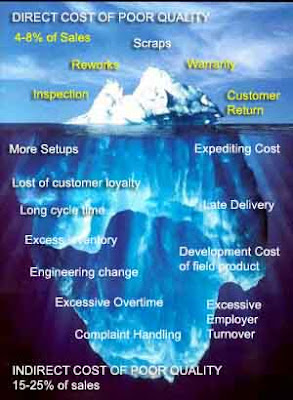Visual
inspection, especially 100% visual inspection, is used by many industries as
part of their Quality or Risk Management programs. Sometimes, as the last
resort, companies implement 100% inspection if the residual risk is deemed to
be high.
Juran, one of
the giants of Quality, has written that, based on his studies performed on
Inspector accuracy, 100% inspection is about 87% effective. Juran gave the
following formula to calculate the Accuracy of an Inspector.
Accuracy of
inspector = percent of defects correctly identified = (d-k)/(d-k+b)
where d = defects reported by the inspector
k = number of
good units rejected by the inspector
d-k = true
defects found by the inspector
b = defects
missed by the inspector, as determined by check inspection
d-k+b = true
defects originally in the product
This brings us
to the next question, is 200% or 300% inspection effective?
From a pure
probability standpoint, multiple inspections are indeed effective. For example,
if we determine that 100% inspection is 85% effective (as an example), we can
then calculate the probability of rejects being identified by at least one
inspector.
P(rejects being
identified by at least one inspector) = 1 – (1- e)^n
where e = inspection effectiveness (85% in the
example)
n = number of
100% inspections (3 in the example)
Thus, we can
determine that the 300% inspection with an inspection effectiveness value of
85% is 99.7% effective. In other words, 300% inspection will still result in
0.3% of the bad product to be missed.
The number of
rejects caught by 100% inspection can be found by the following calculation.
# of rejects
caught = N * p * e
where N = Lot size
p = %
non-conforming product
e = inspection
effectiveness
The least
effective form of quality control is that of inspection by people, people are
fallible and can often fail to observe problems especially if the work is
repetitive and the shift is long. Consider the common exercise often used in
demonstrating the weaknesses of 100% manual quality inspection. Count the
number of F’s in the paragraph below:
THE NECESSITY
OF TRAINING HANDS FOR FIRST-CLASS FARMS IN THE FATHERLY HANDLING OF FRIENDLY
FARM LIVESTOCK IS FOREMOST IN THE MINDS OF FARM OWNERS. SINCE THE FOREFATHERS
OF THE FARM OWNERS TRAINED THE FARM HANDS FOR THE FIRST-CLASS FARMS IN THE
FATHERLY HANDLING OF FARM LIVESTOCK, THE OWNERS OF THE FARMS FEEL THEY SHOULD
CARRY ON WITH THE FAMILY TRADITION OF TRAINING FARM HANDS IN THE FATHERLY
HANDLING OF FARM STOCK BECAUSE THEY BELIEVE IT IS THE BASIS OF GOOD FUTURE
FARMING.
How many did
you get?
There are 48
f's, however most people will not get the right answer; their answers will vary
between about 30 and 60 letter “f”s in the paragraph having missed letters or
double counted.
W. Edwards
Deming suggested that inspection is too little too late: "Cease reliance
on mass inspection to achieve quality. Eliminate the need for inspection on a
mass basis by building quality into the product in the first place."
He didn't call
for the elimination of inspection altogether, but rather for its reduction to
the optimal level. Some inspection is always necessary and is an important tool
for gathering data about what you are doing. But 100 percent inspection is
seldom appropriate and is costly in both time and money. And most important,
inspection cannot always catch problems that are inherent in the system itself.
Rafael Aguayo,
author of Dr. Deming: The American Who Taught the Japanese About Quality, makes
this point vividly in his book: "The disastrous explosion of the space
shuttle Challenger was apparently due to the failure of rubber O rings. The
rings in the Challenger were within specifications. No amount of inspection
would have prevented them from being used. But the rings tended to fail in
extreme cold. It was only a matter of time before a tragedy occurred.
Inspection cannot improve the level of quality that is designed into the
product."
Too much
reliance on inspection also supports a "blame the worker" mentality
that is antithetical to today's understanding of what drives quality
improvement. The health care field is richly populated with individuals who are
highly committed to doing the right thing for their patients, no matter what is
required. But even extraordinary people cannot consistently rise above a system
that is poorly designed.
When
organizations work to improve processes and systems, the opportunities for
"defects" to occur are systematically reduced. Inspection then
becomes useful as a means of gathering data to drive further quality
improvement efforts, rather than a hunt for mistakes and those responsible for
them.
Harold F.
Dodge, principal architect of statistical quality control, has stated that “You
cannot inspect quality into a product.” The feedback loop should be as small as
possible for an inspection activity to be value adding. This feedback also has
the benefit of improving the process since the operator is made aware of the
issue almost immediately. The best case is to have poke-yoke or mistake
proofing such that mistakes do not happen at all.









